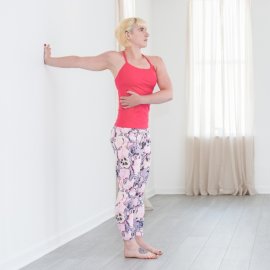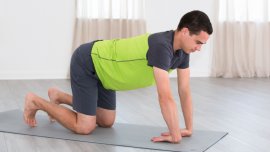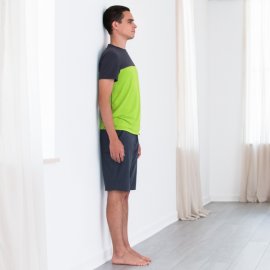
 Soften your forehead and unclench your jaw. Allow your breath to slow and deepen.
Soften your forehead and unclench your jaw. Allow your breath to slow and deepen.
Compare your alignment in mountain pose to your usual postural tendencies. Are your head and tailbone usually in the same upright line, as they are now, or does this position feel unusual? “Man is timid and apologetic; he is no longer upright; he dares not say ‘I think, I am, ’ but quotes some saint or sage, ” Ralph Waldo Emerson bemoans in Self-Reliance. Why not try writing with the openness and confidence that this pose embodies—hiding nothing, and daring to say exactly what you think and who you are?
1b. Mountain Pose with Eye Movements
Continue to stand tall, with your back against a wall. Look at something near you, then at something far away. Look right, then left. Up, then down. Circle your eyes in one direction, and then the other. After several breaths, shut your eyes and repeat these eye movements behind your closed lids. Then allow your closed eyes to be still. Imagine the muscles around your eyes smoothing out, the muscles behind your eyes smoothing out, even your brain itself unwrinkling.
These eye movements are vital if your gaze has been fixed for some hours at a screen or page. You can shift the focus of your mind’s eye, too: you need never be stuck. Just as you can move your eyes, so also can you shift your writerly attention. Perhaps the story you were looking for has been waiting for you just above, below, or to the side of the story you thought you were telling. Perhaps the solution you needed is already there, just lingering beneath the surface at another depth.
 2. Shoulder Stretch at Wall
2. Shoulder Stretch at Wall
Stand with the right side of your body an arm’s length from a wall. Place your right hand on the wall at about the height of your nose, with the fingers pointing up and back slightly. Walk forward until you feel a shoulder and chest stretch, so that your arm is lengthening back behind you on a diagonal. Cross your left arm in front of your torso, bringing your left hand to the right side of your rib cage (as though giving yourself half of a hug), then gently spin the right side of your chest forward, away from the hand that’s reaching back. Press into the base of your right index finger, and into all the fingertips of your right hand, and try to move the wall forward. Back out of the stretch if you feel pain or numbness; work at the position just before the discomfort starts, and breathe there. Walk back to your starting position before releasing and repeating on the second side.
It’s possible that you hate doing this pose, which can be wildly intense (especially if your shoulders are used to rounding). But perhaps you like having done this pose—your shoulders might feel liberated afterward, and it might be easier to breathe. If, like Dorothy Parker, you hate writing, you might take the pleasant aftereffects of this pose as a reminder of how much you like “having written.”
Come down to your hands and knees, arranging yourself in tabletop with your hands below your shoulders and your knees below your hips. Point your fingers toward your knees, palms down. (If this is too much for your wrists, turn your fingers out to the sides instead.) Take care not to hyperextend your elbows, keeping the eyes of your elbows soft. As you inhale, round your back toward the ceiling. As you exhale, backbend your spine, tipping your tailbone up and back and bringing your heart forward, while lightly drawing your belly in. (Exhaling as you backbend has the advantage of offering the lower back the support of the belly in “cow, ” and lets us practice harnessing abdominal support without tucking the tailbone under.)
As you exhale, backbend your spine, tipping your tailbone up and back and bringing your heart forward, while lightly drawing your belly in. (Exhaling as you backbend has the advantage of offering the lower back the support of the belly in “cow, ” and lets us practice harnessing abdominal support without tucking the tailbone under.)
After several breaths of this, switch your hand position, turning your palms up and pointing your fingers back toward your knees. Press the backs of your hands into the mat, and again cat-cow your spine. Next, turn your fingers to face each other (palms still up), and again flex and extend your spine, pressing the backs of your hands. Make fists if you want more intensity, keeping the backs of your hands on the mat.
These poses limber your spine while stretching your wrists, and they can be important after working on a keyboard or clutching a pen. Imagine these movements clearing any obstructions in the passage of your ideas from your brain to your hands, enhancing your ability to write—or “think through your fingers, ” as Isaac Asimov defined it.
5. Hopping Dog
From tabletop position, place your palms down, fingers forward and rooting down through the bases of your index fingers. Curl your toes under, lift your hips up and back, and move into downward facing dog. Bend your knees enough that your sitting bones can tip up and back, and your lower back can curve in toward your belly. Now take several small jumps in place, as if you are springing over a jump rope, being careful to maintain your lumbar curve and to land softly, with knees bent and tracking toward your middle toes. If this is going well, for more intensity, make your hops bigger, into “donkey kicks, ” moving the heels toward the sitting bones.
As you hop in this spine-lengthening pose, imagine you are banishing stagnation, jostling stuck energy, and channeling vitality from your legs toward your brain. As Henry David Thoreau wrote in his journal: “Methinks that the moment my legs begin to move, my thoughts begin to flow.” Here, you can also stomp down any impediments to your work, such as plans, worries, critical comparisons, or sleepiness.
6. Moving Baby Cobra, Lowering an Ear to the Floor
Come down to your belly, hands alongside your chest. Anchor the tops of your feet, your knees, and your pubic bone. Keep your belly on the mat, and as you exhale, peel your head, shoulders, and chest up off the floor. Lower down on the inhale, bringing one ear to the ground. Lift up on the exhale, then lower your other ear to the ground. Come up and down a few times, rising on your exhales, and then hold baby cobra for a few breaths.









